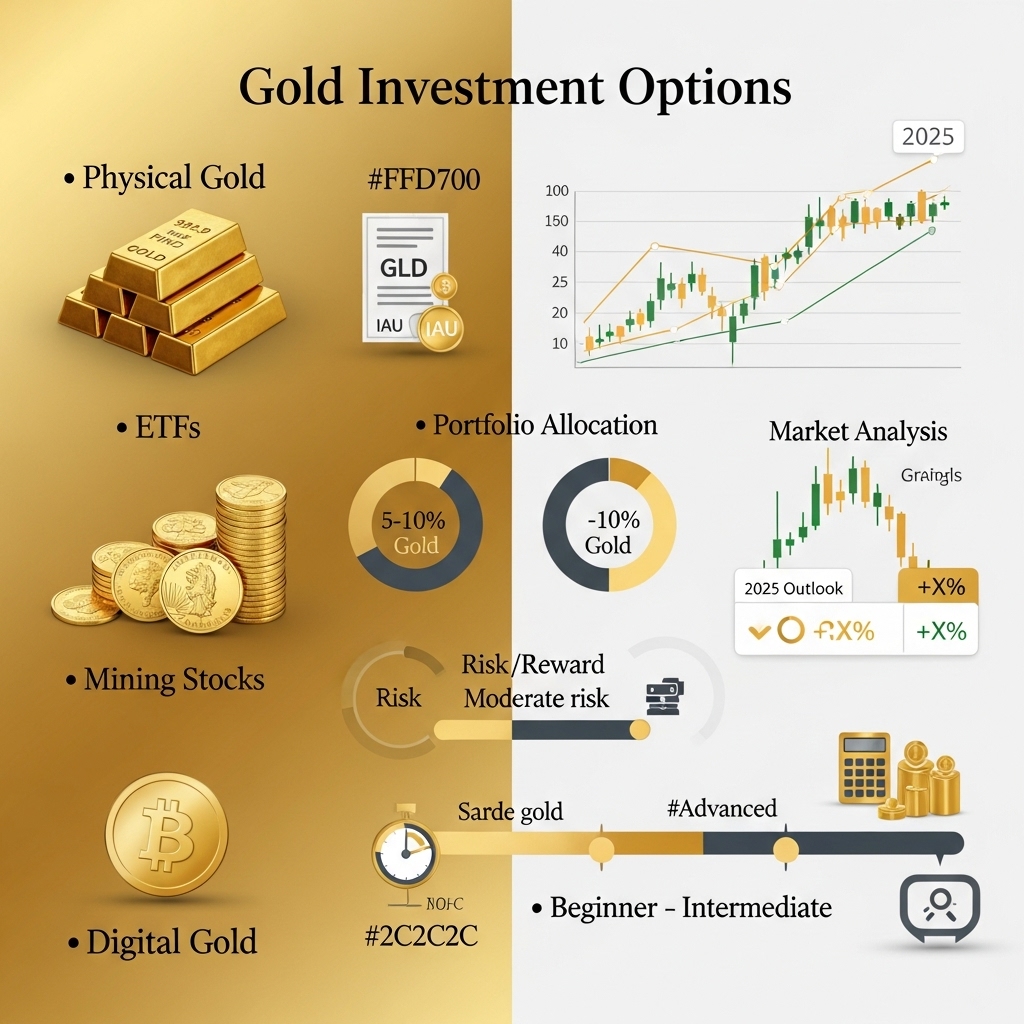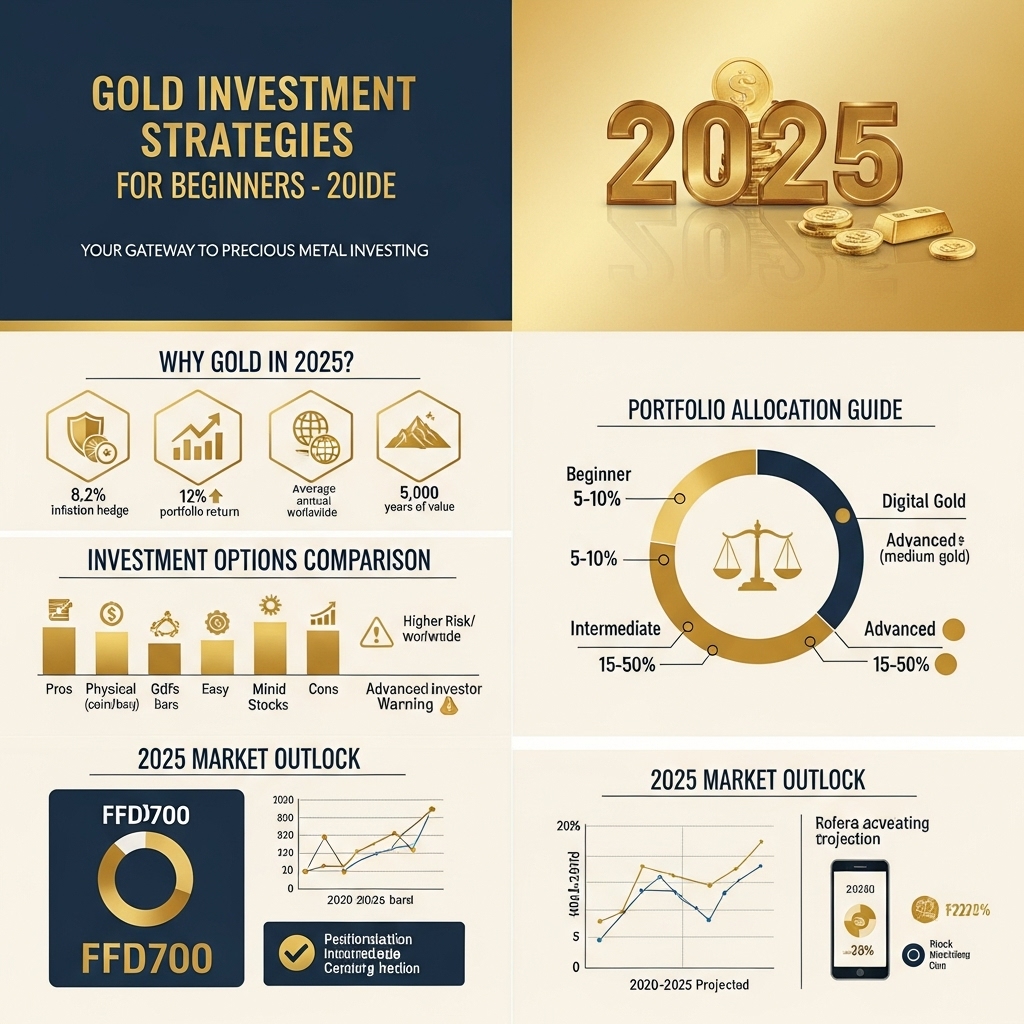Gold Investment Strategies for Beginners in 2025: Your Gateway to Precious Metal Wealth
Picture this: While stock markets experienced unprecedented volatility throughout 2024, gold quietly surged past $2,400 per ounce, rewarding savvy investors who recognized its enduring value as a financial safe haven. As we enter 2025, central banks continue their aggressive gold accumulation, geopolitical tensions persist, and inflation concerns linger—creating a perfect storm of conditions that historically favor gold investments.
If you’ve been watching gold’s impressive performance from the sidelines, wondering how to transform this ancient store of value into a modern wealth-building strategy, you’re in the right place. This comprehensive guide will walk you through proven gold investment strategies specifically tailored for beginners, covering everything from physical bullion and gold ETFs to mining stocks and digital gold platforms. We’ll explore current market dynamics, decode the factors driving gold prices, and reveal practical techniques for portfolio diversification that seasoned investors use to protect and grow their wealth.
Understanding gold investment strategies isn’t just about chasing returns—it’s about building financial resilience in an uncertain world. Whether you’re seeking portfolio insurance against market crashes, hedging against currency devaluation, or simply diversifying beyond traditional assets, gold offers unique benefits that complement any serious investment approach. By mastering these beginner-friendly strategies, you’ll gain the confidence to navigate the gold market and potentially secure your financial future with one of history’s most trusted assets.
Gold Market Analysis and Key Insights
Current Market Fundamentals and Price Drivers
Gold continues to demonstrate resilience in 2025, with prices hovering near historical highs driven by persistent inflation concerns and geopolitical uncertainties. Central bank purchases reached record levels in 2024, with continued strong demand from emerging economies seeking to diversify their reserves. The Federal Reserve’s monetary policy shifts and global economic volatility have reinforced gold’s appeal as a safe-haven asset.
Investment Vehicle Performance Comparison
Physical gold ownership through coins and bars offers direct exposure but involves storage costs and insurance considerations. Gold ETFs provide liquidity and convenience, with expense ratios typically ranging from 0.25% to 0.40%. Gold mining stocks have shown higher volatility, delivering amplified returns during gold rallies but increased downside risk during market corrections. Digital gold platforms have emerged as cost-effective alternatives for smaller investors, enabling fractional ownership with lower transaction fees.
Portfolio Allocation and Risk Management
Financial experts recommend allocating 5-10% of investment portfolios to gold for optimal diversification benefits. Gold’s negative correlation with stocks during market stress periods makes it an effective hedge against equity volatility. However, investors should recognize that gold generates no income and may underperform during periods of economic growth and rising real interest rates.
Strategic Entry Points and Timing
Dollar-cost averaging remains the preferred strategy for beginners, reducing timing risk through systematic monthly purchases. Market analysts suggest monitoring key indicators including the US Dollar Index, real interest rates, and inflation expectations when making larger allocation decisions. Current market conditions favor gradual accumulation rather than lump-sum investments.
Expert Outlook and Recommendations
Leading analysts project continued support for gold prices through 2025, citing ongoing monetary policy uncertainties and persistent geopolitical tensions. Beginners should prioritize established, low-cost investment vehicles and maintain realistic expectations about returns. Building gold positions gradually while maintaining proper portfolio balance ensures sustainable long-term wealth preservation strategies.

Gold Investment Strategies and Options
Physical Gold vs. Paper Gold
Beginners can choose between physical gold (coins, bars, jewelry) and paper gold (ETFs, mining stocks, futures). Physical gold offers tangible ownership and crisis protection but requires secure storage and insurance. Gold ETFs provide liquidity and lower transaction costs, making them ideal for portfolio diversification without storage concerns.
Strategic Investment Approaches
Dollar-cost averaging is the most beginner-friendly strategy, involving regular monthly purchases regardless of price fluctuations. This method reduces timing risk and smooths out market volatility. Lump-sum investing works best during economic uncertainty or currency devaluation periods.
Core-satellite approach combines a stable gold ETF foundation (core) with tactical investments in mining stocks or gold futures (satellites) for enhanced returns.
Risk Assessment and Portfolio Allocation
Financial advisors typically recommend 5-10% gold allocation for beginners, with conservative investors favoring the lower range. Gold serves as portfolio insurance rather than a growth vehicle, providing stability during market downturns and inflation periods.
Consider your risk tolerance: physical gold offers maximum security but limited liquidity, while mining stocks provide higher return potential with increased volatility.
Market Timing Considerations
Gold performs well during economic uncertainty, high inflation, and currency weakness. However, timing the market consistently proves difficult. Focus on long-term trends rather than short-term price movements.
Monitor key indicators: real interest rates (negative rates favor gold), inflation expectations, and geopolitical tensions. Avoid emotional decisions during price spikes or crashes.
Start with small positions to gain experience, gradually increasing allocation as you understand market dynamics and your risk preferences.
Market Performance and Outlook
Gold has demonstrated remarkable resilience as an investment asset, delivering an average annual return of approximately 7.8% over the past two decades. During periods of economic uncertainty, including the 2008 financial crisis and COVID-19 pandemic, gold prices surged significantly, reaching all-time highs above $2,000 per ounce in 2020 and again in 2024.
Currently, gold markets are experiencing heightened volatility driven by conflicting pressures. Central bank purchases remain robust, with institutions adding over 1,000 tonnes annually since 2022. However, rising interest rates and a strengthening dollar have created headwinds for gold prices throughout 2024.
Looking ahead to 2025, several factors suggest cautious optimism for gold investors. Geopolitical tensions, persistent inflation concerns, and potential monetary policy shifts could support higher prices. Many analysts project gold trading between $2,100-$2,400 per ounce, though significant volatility is expected.
Key economic drivers include Federal Reserve policy decisions, inflation trends, and global currency fluctuations. The dollar’s strength remains inversely correlated with gold performance, while mounting government debt levels worldwide may increase safe-haven demand.
For 2025, beginners should anticipate a market characterized by periodic volatility but underlying strength. Gold’s traditional role as a hedge against economic uncertainty remains intact, though investors should prepare for price swings ranging 15-25% annually while maintaining focus on long-term wealth preservation rather than short-term gains.
Frequently Asked Questions About Gold Investment
What is the best way for beginners to invest in gold in 2025?
Beginners should start with gold ETFs or mutual funds, which offer exposure to gold prices without physical storage concerns. These options provide liquidity, lower costs, and professional management. Physical gold coins or bars are ideal for those wanting tangible assets, while gold mining stocks offer potential for higher returns but carry additional company-specific risks.
How much of my portfolio should be allocated to gold?
Financial experts typically recommend 5-10% portfolio allocation to gold for diversification purposes. This percentage can increase during economic uncertainty or inflation periods. Beginners should start conservatively and gradually increase exposure as they gain experience and understanding of gold market dynamics.
What are the main costs associated with gold investing?
Costs vary by investment method. Physical gold involves dealer premiums, storage fees, and insurance costs. ETFs charge annual expense ratios (typically 0.25-0.75%). Gold mining stocks have brokerage fees. Always factor in these costs when calculating potential returns.
When is the best time to buy gold?
Gold often performs well during inflation, currency devaluation, and market volatility. However, timing the market is challenging. Dollar-cost averaging through regular purchases can help reduce timing risk and smooth out price fluctuations over time.

Final Thoughts on Gold Investment
As we’ve explored throughout this guide, gold remains a valuable portfolio diversifier for beginners in 2025. The key takeaways include starting with 5-10% portfolio allocation, choosing between physical gold, ETFs, or mining stocks based on your risk tolerance, and maintaining a long-term perspective despite short-term volatility.
Remember that gold serves as insurance against inflation and economic uncertainty rather than a get-rich-quick scheme. Dollar-cost averaging into gold positions can help smooth out price fluctuations while building your precious metals exposure gradually.
Our recommendation: Begin with gold ETFs for simplicity and liquidity, then consider physical gold as you gain experience and confidence.
Ready to start your gold investment journey? Research reputable gold dealers and brokers, set your budget, and take that first step toward portfolio diversification. Your future self will thank you for this strategic addition to your investment arsenal.